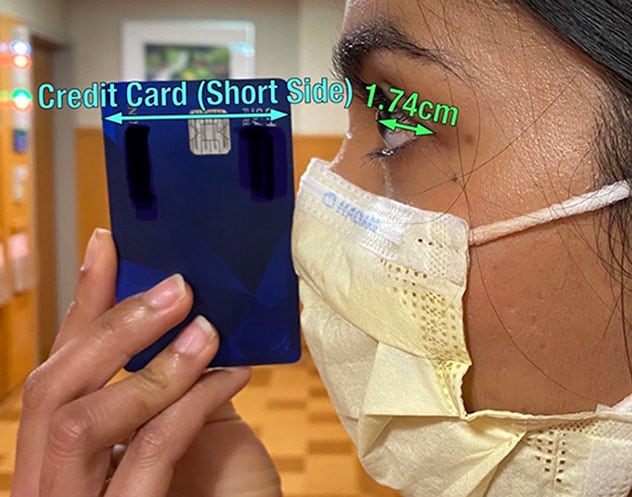March 12, 2022
Hertel exophthalmometry is the most commonly used modality for measurement of globe position, which is important to quantify the amount of displacement caused by orbital disease. Sometimes, however, a Hertel device is not readily available. "We wondered whether a mobile application might provide an alternative measuring strategy," says Andrea A. Tooley, M.D., Ophthalmology, at Mayo Clinic in Rochester, Minnesota. To test that concept, Dr. Tooley and fellow researchers compared the reliability of a novel exophthalmometry method that uses a smartphone platform to current standards.
Mobile exophthalmometry device
 قياسات جحوظ العين
قياسات جحوظ العين
تعرض صور الوجه السهمية مع استخدام بطاقة ائتمان قياسية كمرجع نتائج قياس جحوظ العين والتي أُنتِجت باستخدام تطبيق هاتف ذكي. حسب ما ورد في مجلة Orbit.
The mobile exophthalmometry device employs a readily accessible mobile ruler application that digitally extrapolates unknown static measurements based on known values. The researchers used it to obtain measurements of axial globe position through sagittal facial photos obtained with the patient holding a standard credit card (known measurement) midline and parallel to the apex of the cornea, while the observer and cellphone camera were positioned at a 90-degree angle to the plane of the credit card.
The lateral orbital rim and apex of the cornea were used as landmarks. The distance between the two was determined by manually identifying the landmarks with the measuring arrow, which generated a calibrated 2D measurement based on the credit card width.
Multiple independent measurements were obtained from a single photo by each observer to report the interobserver and intraobserver reliability. Observers repeated mobile measurements 2 to 4 times on each patient photo over a period of six months.
The study
The prospective, comparative study included 50 patients (99 eyes) for a total of 594 mobile measurements between two observers. The study included patients with extreme exophthalmos as well as enophthalmos after orbital fractures and trauma to represent variability and evaluate limitations at extremes of measurement. The intermodality correlation and agreement between Hertel and mobile exophthalmometry and the intraobserver and interobserver reliability with repeated mobile measurements were the main outcomes.
Results
Researchers found no significant difference in the measurements obtained by Hertel and mobile exophthalmometry. There was a strong linear correlation between Hertel exophthalmometry and mobile exophthalmometry with a Pearson correlation coefficient of 0.910 and 0.888 for the right and left eyes, respectively. Bland-Altman plot analysis showed excellent agreement between the two modalities.
The mobile exophthalmometry platform demonstrated high intraobserver reliability with a Cronbach's alpha of 0.992 and 0.985 for the right and left eyes, respectively. An intraclass correlation coefficient of 0.992 (95% confidence interval, 0.987-0.995) for the right eye and 0.986 (95% confidence interval, 0.978-0.991) for the left eye demonstrated excellent reliability between observers.
Dr. Tooley notes: "Study results demonstrate strong correlation between Hertel and mobile measurements. Even novice observers obtained accurate measurements for most photos. Extensive user education and experience may not be required.
"Pre-labeled reference and measuring arrows are automatically generated following the acquisition of the photograph for immediate measurements, and unmeasured photographs may be stored and measured at a later time.
"Although a 2D measurement does not replace the 3D view of Hertel exophthalmometry, this simple-to-use mobile application yields reliable, accurate measurements in a timely, efficient manner — and may be a suitable alternative when Hertel exophthalmometry is not available."
Study results were published in Orbit in 2021.
For more information
Magazin M, et al. Utilizing a mobile platform to obtain quantitative measurements of exophthalmos. Orbit. In press.
Refer a patient to Mayo Clinic.